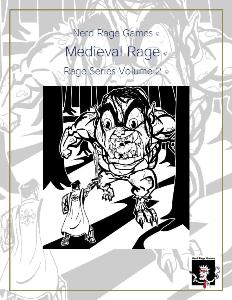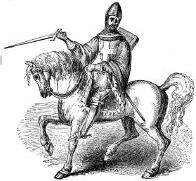
Product Name: Medieval Rage
Publisher: Nerd Rage Games
Author: Richard Green, Nicholas Huth, BJ Lewis, Zachariah Stevenovich
System: Rage Series
Setting:
Series:
Theme: Epic Fantasy
Type: Core
Link: http://www.nerdragegames.webs.com/
Medieval Rage is the second core product of a series of role-playing games using the Rage system (also known as the Rage Series). The Rage system is a modular game system allowing different settings, including genres, to be used as a plug-n-play situation to allow for customization of an individual adventure or campaign. Each core setting is designed to be compatible with other settings allowing the mixture of genres and a totally unique gaming experience. Medieval Rage introduces fantasy into the system with an epic fantasy style using common fantasy and medieval themes.
For mechanics, Rage is a roll-under system using a d20 and a target number based off a characters skills and attributes. For opposed encounters, the attacker compares their skill to the defenders’ skill and the difference becomes the target number. This means that with improvements to a characters attributes, skills, or equipment, rolling under that target number becomes increasingly easier (unless coming across an increasingly stronger foe). Medieval Rage brings about a wealth of fantasy mechanics through a large listing of spells and melee weapons. However, the game-play mechanics are relatively simple to keep games moving without having to spend time referencing the rulebook.
CHARACTER CREATION

Character Creation starts out with the introduction of the available races. This Medieval Rage core setting book presents five fantasy races (human, elf, dwarf, orc, and fairy) with four of them being staple fantasy races. I question the use of the fairy race in a core setting book, but understand that they’re geared more toward magic and can bring about a much different experience than the other four.
Character Creation moves on to calculating character attributes and target number bonuses. This section is identical to Space Rage, so I won’t go into further details. For a look at this section of Character Creation, refer to the already posted Space Rage review here. There are added mechanics for blood type and their associated bonuses which I find quite interesting. This brings about the possibility for having half-race characters.
Character Creation continues with the list of archetypes and categories. These are fairly limited for a fantasy-based system, but at least allow for enough different character types to keep you adventuring team unique and interesting. Many of these archetypes are fantasy standards with the addition of the Noble/Aristocrat to give it the system that true medieval feel. Character Creation finishes up with choosing skills and powers to finalize your character.
MECHANICS
Skill and combat mechanics are virtually identical to Space Rage, so once again I will not go into too much detail. If you wish to read about these mechanics, refer to the Space Rage review here.
Medieval Rage brings a deeper look into Psionic abilities and brings about Arcane and Divine spells (both referred to collectively as Sorcerer Spells). These spells and abilities are few in number but extensive in effect. Instead of having 10 spells that basically do the same thing, this is narrowed down to a single spell with the flavor text being vague enough that any player can create their own visual effect.
After these spells comes the skill lists. Fantasy-based systems don’t really need a high number of skills, Medieval Rage has a lot of available skills. The list is a bit too long and many of these skills could be combined as they do similar tasks or could be incorporated into a new skill that encompasses multiple skills from this list. However, each skill is properly listed with its applicable attribute(s) and description.
The last mechanic is another found in Space Rage: followers. The followers mechanic is identical to the Space Rage mechanics and thus allow the characters to build entire armies.
EQUIPMENT
The list of mundane equipment is long and comprehensive, the list of weapons and armor is very short. However, there is a fantastic mechanic that utilizes this short list of weapons and armor in a fantastic way. Creating magical items is a simple process of enchanting that item (although enchanting may not be all that simple) and thus giving that item the applicable bonus. This means the system can maintain a limited number of items but allow them to grow into fantastic magical items. This mechanic keeps with the rules-light system and prevents the players from having to search through a listing of hundreds of items just to find the right one. The equipment mechanics finishes off with the appropriate tools for creating those magical items along with lists of unique magical items that could be found through the course of adventuring.
BESTIARY
The bestiary section consists of 31 creatures and monsters of typical fantasy styling. Each one is properly described with applicable attributes, skills, weapons, treasure, and description. I would like to see more illustrations, but so many of these have been illustrated numerous times throughout many other systems that they should be familiar to most players.
OVERALL
Overall I think Medieval Rage is a good addition to the Rage Series. The fantasy mechanics are concise without being convoluted. The spell and weapon lists are short but contain more than enough to enjoy game-play. And without a defined setting, the options are quite vast for further expansion.
RATINGS
Publication Quality: 5 out of 10
Like Space Rage, Medieval Rage could benefit from the same previously mentioned improvements, so I won’t go into detail again here. The rest of the publication utilizes a smooth and easy-to-follow layout. There are a fair number of illustrations, while small in size, offer a good amount of visual appeal to the content being presented. One other improvement that could be made is the background; it’s a bit dark and sometimes gets in the way of reading the material. The mechanics are still solid and layout can be easily fixed.
Mechanics: 9 out of 10
Medieval Rage utilizes a much simpler look at Epic Fantasy. The number of spells is short and thus keeps game-play from becoming bogged down by having to memorize a very large list of spells. The list of weapons is also short, with mechanics to make them fantastic. Instead of creating 20 different versions of similar weapons, there are mechanics to take the base weapon and enchant it, thus creating a magical weapon. These magical weapons offer standard bonuses and more enchantments can be made to further these bonuses. This is a nice clean mechanic that keeps the system from becoming bloated with a huge number of weapon options. These are just two of the mechanics provided that keep the system being rules-light.
Desire to Play: 7 out of 10
While I like the simplicity of the system and the rules-light mechanics, I find the number of skills to be excessive for a fantasy-based game. With the lack of high-technology and the need for modern activities, a limited number of skills is really all you need to play a fantasy system. Some of the listed skills could be combined while some of them could simply be eliminated. That being said, I find the simplicity of the combat mechanics has the possibility for faster game-play while still offering enough options to keep the game interesting.
Overall: 7 out of 10
Medieval Rage appears to be a good addition to the Rage Series. Although unlike Space Rage, Medieval Rage has more fleshed out mechanics for small skirmishes along with mechanics for creating larger armies. The system brings a good amount of fantasy content into the system with a great listing of spells and weapons. I like the direction the Rage Series is taking and find it quite unique to have the ability to mix modules while utilizing the same mechanics throughout.
